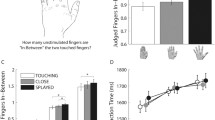Abstract
Twenty-four aphasic and fifteen right brain-damaged subjects were compared on their ability to identify the objects whose use was depicted in a series of twenty videotaped pantomimes. Aphasics were inferior to right brain-damaged patients in inferring object use. Success was correlated with Performance IQ, but not with language measures. Analysis of movement features contributing to subjects' choices reveal speed of movement and object weight to be the most robust and hand shape and size to be the most fragile.
Similar content being viewed by others
References
Borod, J. C., P. Fitzpatrick, N. Helm-Estabrooks, and H. Goodglass: 1989, ‘The Relationship Between Limb Apraxia and the Spontaneous use of Communicative Gesture in Aphasia’,Brain and Cognition 10, 121–31.
De Renzi, E.: 1989, ‘Apraxia’, in Boller, F. and Grafman, G. (eds.),Handbook of Neurolopsychology, Elsevier, Amsterdam, 245–62.
Duffy, J., R. Duffy, and K. L. Pearson: 1975, ‘Pantomime Recognition in Aphasic Patients’,Journal of Speech and Hearing Research 18, 115–32.
Duffy, R. and J. Duffy: 1981, ‘Three Studies of Deficits in Pantomime Expression and Pantomimic Recognition in Aphasia’,Journal of Speech and Hearing Research, 70–84.
Duffy, R. and B. Liles: 1979, ‘A Translation of Finkelnburg's (1870) Lecture on Aphasia as ‘Asymbolia’ with Commentary’,Journal of Speech and Hearing Disorders 44, 156–68.
Gainotti, G. and R. M. Ibba: 1972, ‘La comprensione del significato dei gesti simbolici negli afasici’,Minerva Psichiatrica e Psychologica 13, 1–9.
Gainotti, M. and M. A. Lemmo: 1976, ‘Comprehension of Symbolic Gestures in Aphasial’,Brain and Language 3, 451–60.
Goodglass, H. and E. Kapian: 1963, ‘Disturbance of Gesture and Pantomime in Aphasia’,Brain 66, 703–20.
Marr, D. and L. M. Vaina: 1982, ‘Representation and Recognition of the Movement of Shapes’,Proceedings of the Royal Society 214b, 501–24.
Napier, J.: 1956, ‘The Prehensile Movements of the Hand’,Journal of Bone and Joint Surgery 38b(4), 902–13.
Rosch, E.: 1973, ‘On the Internal Structure of Perceptual and Semantic Categories’, in T.S. Moore (ed.),Cognitive Development and the Acquisition of Language. Academic Press, New York/London.
Seron, X., A. van der Remitz, and M. van der Linden: 1979, ‘Pantomime Interpretation in Aphasia’,Neuropsychologia 1, 661–8.
Vaina, L. M.: 1983, ‘From Shapes and Movements to Objects and Action’,Synthese 54 1–36.
Vaina, L. M. and Y. Bennour: 1985, ‘A Computational Approach to Visual Recognition of Arm Movements’,Perceptual and Motor Skills 60, 203–28.
Vaina, L. M. and M. Jaulent: 1991, ‘Object Structure and Action Requirements: A Compatibility for Functional Recognition’,International Journal of Intelligent Systems 6, 313–36.
Varney, N. R.: 1978, ‘Linguistic Correlates of Pantomime Recognition in Aphasic Patients’,Journal of Neurology, Neurosurgery and Psychiatry 43, 71–5.
Varney, N. R.: 1982, ‘Pantomime Recognition Defect in Aphasia: Implications for the Concept of Asymbolia’,Brain and Language 15, 23–39.
Varney, N. R.: 1978, ‘Pantomime Recognition Test’, Dept. of Neurology, University of Iowa Hospitals, Iowa City, IA.
Varney, N. R.: 1978, ‘Pantomime Recognition Test’, Dept. of Neurology, University of Iowa Hospitals, Iowa City, IA.
Author information
Authors and Affiliations
Additional information
This study was supported in part by the grants from the National Institute of Health (RO1 EY07861) and McDonnell Pew Foundation (T89-01245-017) to LMV and by the USPHS grant NS06209 to H.G. and L.M.V. The authors are indebted to the staff of the Neuropsychology and Communication Disorders Departments at the New England Rehabilitation Hospital for making available the test records of the patients included in this study. All the patients included in the study have signed the informed consent forms according to the regulations of the Human Subjects Committee at New England Rehabilitation Hospital.
Rights and permissions
About this article
Cite this article
Vaina, L.M., Goodglass, H. & Daltroy, L. Inference of object use from pantomimed actions by aphasics and patients with right hemisphere lesions. Synthese 104, 43–57 (1995). https://doi.org/10.1007/BF01063674
Issue Date:
DOI: https://doi.org/10.1007/BF01063674




